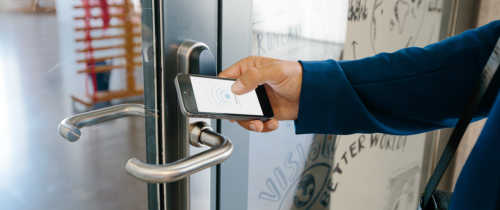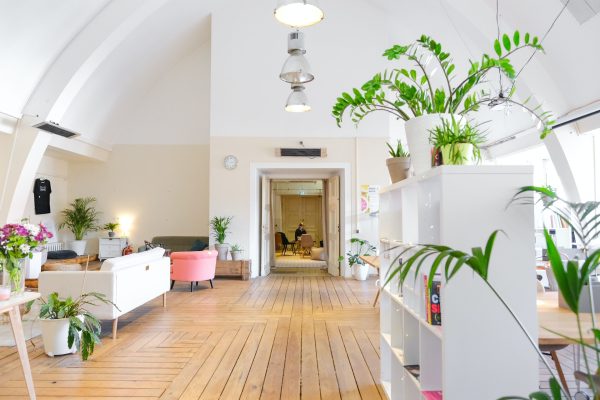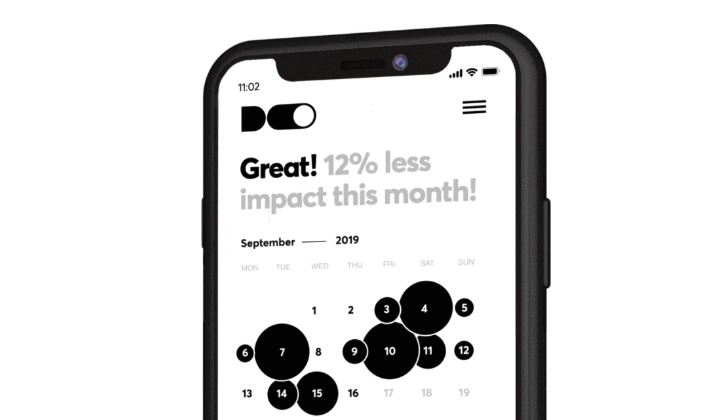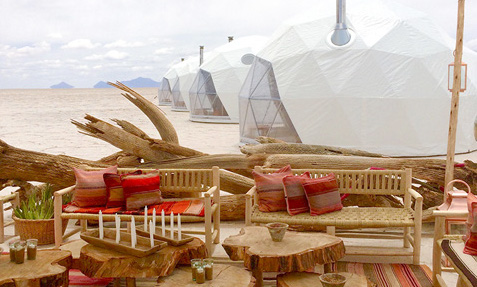How is Covid-19 redefining the User Experience Design in ‘co’ spaces?. In this article we look into what will be the future of ‘co’ spaces (i.e. hotels, coliving and coworking spaces) and how user experience (UX) can play a vital role in fostering authentic community and connection amidst new health and safety guidelines and other post Covid-19 measures.
We have interviewed Anna Sundukova (AS) and Felix Burghardt (FB), two user experience and spatial design experts from Berlin and Amsterdam working in the hospitality, coworking and coliving fields. They will explore what the future of these sectors look like, with a focus on the user experience and spatial design strategies when considering the need to prepare for future health crises such as Covid-19 (and wider health issues such as loneliness and social isolation).
This is part two of a blog series that was originally posted in the Conscious Coliving blog, in which the first article looked into ‘7 tips for enhancing UX during crisis’. This article was also featured in the latest edition of Coliving Insights, ‘Is Coliving Here To Stay?’. Also, here you can read our article on “coliving design & architecture on the age of Covid-19″.
How pandemics shape our user experience
The user experience in ‘co’ spaces has changed significantly over the last few months. Whether that means high vacancies in office spaces or shared living communities with closed communal spaces, the ‘co’ space has certainly been impacted by the recent pandemic.
But is it only for the worse? Our interviewees for this article, Anna Sundukova and Felix Burghardt, don’t think so. In this article they share their insights into the trends that they have seen emerge and accelerate due to Covid-19.
Anna and Felix share with us a bright and quirky future for ‘co’ spaces: one of flexibility, digitalisation, sustainability and personal and collective transformation. Without putting on rose-coloured glasses, they shine some light on how coliving, coworking and hospitality operators can enhance their user experiences and ultimately become partners, rather than providers, of community and impact.
Take a seat, stand up, read aloud … have a think about and feel into your current user experience in this moment, and dive into this insightful interview piece from ‘co’ space designers Anna Sundukova and Felix Burghardt.
What are the key UX challenges for shared spaces in the lieu of Covid-19?
Anna Sundukova:
As the most urgent and immediate user need and requirement has been safety and protection of personal health, the immediate challenge for all shared spaces during Covid-19 is to provide a pop-up infrastructure of ad-hoc measures in order to redistribute available space, ensure enough physical distance and increase hygiene.

A lot can be learned from the office sector, where many designers, landlords and operators have come up with thought-through and easily implementable frameworks to ensure maximum safety and comfort. Thinking about topics like density of occupancy, circulation patterns, pathway tightness and applying nudges for simple behavioural changes, like the Happy Birthday song principle, can be considered as fairly low cost interventions with considerable impact.
The other key challenge and an acute human need is around trying to maintain sanity and emotional stability, which was compromised by enforced social isolation. And this is where coliving spaces in particular seem to have made a significantly valuable contribution to the lives of their guests just by the nature of being communal living spaces. As most of us were struggling with the implications of living in highly individualistic self-contained homes, coliving dwellers reported that the naturally built-in social support systems and relationships have greatly supported their wellbeing through the challenging times.
Many ‘co’ spaces also took their community building efforts online, not only to support their members emotionally in isolation but also to upkeep the engagement with the larger community.
How do you think the spatial design of coliving spaces will be affected by the pandemic?
Anna Sundukova:
In my opinion a slightly different question is more important at the moment: how will we allow the pandemic to affect the design of shared spaces? I am cautiously optimistic in hoping that we will be guided by aspirations and not fear in our spatial design decisions, because spaces are a long-term investment and a product, impacting the urban fabric and culture of its users not just for a few months, but for years to come. So our decisions about fundamental interventions should distinguish between immediate, urgent needs and important long-term changes. If we take this perspective, then we can start seeing distinct trains of thought.
First, I believe that ‘hard’ spatial design, fundamental long-term immovable changes should be guided by the big psychological, emotional needs we have seen brought to the surface. The need for community and connection is one of the most prominent. A humble balcony, a shared backyard or, in the specific case of coliving spaces, the common room – this is what kept people sane throughout the quarantine. This should be a big lesson not only for the coliving sector but for all living spaces in general – invest in building strong, resilient, self-sufficient communities through spatial design decisions, do not let communal places of gathering fall victim to maximising return on investment per square meter.
Second, I believe that immediate interventions and operational changes must by all means respond to the urgent needs at hand.
There is plenty of untapped potential to be found in using technology to make the space safer for its occupiers. For example, to decrease physical ‘touch-points’ and thus the exchange of germs, we could be looking at implementing more contactless technologies, where no real touch is required.

This can be applied to doors, payments, all kinds of switches and more. To decrease human interactions at critical times, sensors could be used to track occupancy levels and advise guests on when it is best to visit or avoid certain public gathering locations. In general, real time data is something the real estate industry, and by extension, spatial design practitioners, are still resistant to. This is a shame, because tracking how space is actually used can not only give you actionable insights regarding hygiene, but also support in making more informed decisions about operating models, future spatial design choices, service processes, making your spaces and business more flexible and adaptable to change.
What could the future of the ‘co’ space look like?
Anna Sundukova:
In my opinion, the future looks good for shared spaces. When we are allowed to work from anywhere – it means we can live anywhere too. So there is no need to lock yourself into long-term expensive rental contracts. We are already seeing the dramatic shift happening in the San Francisco Bay Area where rents dropped 9% year-over-year just in a matter of months. For workplaces, this means a similar thing – if half of your staff is remote, massive office space becomes a waste of money and effort. Demand for flexibility will be shaping much of the future of ‘co’ spaces. So shared space operators should be looking at satisfying this need for convenience and on-demand flexibility, implementing fitting operating models, IT systems and service concepts.
On the other hand, when social support systems shattered and we struggled with mental implications of isolation, having a community to turn to seems so much more important. While work is going remote, we could see more people being interested in shaping their lives in a more communal way outside of work, which will impact how and where they choose to live in the future. From that perspective, a true community is the gold dust for shared spaces and something that is proving to be worthy of investment.
Already last year the coliving sector has been predicted to have a very bright future with market potential at 550bn USD in the next 10 years across Europe and USA, and very likely Covid-19 has brought that future closer. On top of that, I think that new innovators will be coming to the market looking beyond the typologies of coworking and coliving and scaling by building entire systems and networks of interconnected spaces with varied use from retail, leisure and culture to work and fitness. Of course, this is a speculation, but if anything-as-a-service is already defining an era, would not the rise of space-as-a-service be a natural progression?
Felix Burghardt:
We’ve all experienced what kind of impact we can have as a collective during the pandemic. The coliving market especially showed how important it can be to have a supportive community and safety net around you during unprecedented times. And we see already from brands like Adidas and Allbirds, who joined forces to build sustainable shoes, that co-creation and collaboration will become more important in the business world and potentially change the concept of competition to reach common goals. In order to create bigger systemic change we need allies, and therefore we need ‘co’.
What could the future of the office space look like?
Anna Sundukova:
I hope that the future of our offices will be redefined significantly to finally fit better into our lifestyles and to support our mental and physical wellbeing.
Challenging as it was, the pandemic showed that many jobs can be done independent of location and that workers can be successful and productive without constant physical interaction with others.

The politics of control in the workplace embodied in the ‘no-home-office’ policies have been significantly undermined by the obvious truth – most of your work can be done from anywhere.
As tech giants like Twitter, Facebook, Slack and Square are moving tens of thousands of jobs to be permanently remote, we can be sure that other companies, big and small, will follow suit.
As companies and employees start decoupling their identities from occupying and owning large pieces of expensive real estate, will the office disappear completely? I do not think so. But we will start to see that not all work is equal. A recent study shows that people report being much more satisfied with outcomes of their focused work and deep creative thinking at home than if they were at the office. On the other hand, collaboration, team alignment, management and other functions that require direct human interaction seem to suffer from home-office isolation. So, wouldn’t it be natural to suggest that the office should be the container for people coming together, collaborating and sharing, while individual focused work can be done from anywhere, without distractions, more effectively? Going even a step further, I believe we will shift our perspective on using space in a similar way that we did with mobility. Space-on-demand could become the new normal in a few years. Companies could be coming together in a space a few days a week, while on other days another company could be using the same location, saving costs and mitigating the liability attached to long-term leases.
It is not unreasonable to suggest that demand for all shared space will increase because of the newly found freedom for knowledge workers, which is definitely true for coworking and coliving, and we might even be seeing some blended new typologies evolve. For operators of shared spaces, whether for working or living, this means that they need to step up their game. Customers are more and more willing to pay for products and services that meet their needs precisely, and less willing to pay for anything else. So, if you are running any type of shared space make sure you have an intimate understanding of what your guests’ jobs-to-be-done (a UX term for what you could describe as needs) are.
What could the future of hospitality and coliving look like?
Felix Burghardt:
We cannot predict the future with certainty but we can gather different perspectives to create possible scenarios of what the future might hold. I would like to share 3 key insights that will have a larger impact on the customer experience of the hotel and coliving spaces of tomorrow.
Conscious Traveling:
While hospitality slowed down almost entirely during the health crisis, we could already see a more conscious and ecological approach when it comes to traveling. Flight shaming was gaining a lot more popularity as well as the movement of slow traveling. Sustainable banking service Doconomy has created a credit card that stops spending when people reach a carbon limit. And the Arctic Blue Hotel introduced carbon billing at the end of the stay to remind their guests to make more considerate choices.

This newly gained sustainable approach to hospitality combined with the safety concerns of many people and governmental restrictions, could lead to more local tourism and an increase in staycations. For destinations further away, the journey itself will become more important and the decision to travel a more conscious one.
Off the radar these two factors could also spark virtual and gamified tourism. Escaping into virtual worlds could eventually help people have a sustainable vacation while recovering from the financial impact of the crisis without risking their health.
For hospitality and coliving brands it will be essential to openly share and show the ecological measurements and value they create as well as to embed the actual travel phase into the customer journey and design for the feeling of security.
In the long-term it will be interesting to see how hotels and coliving spaces can make use of the online world to make their business models more resilient. Did someone say digital spa?
The Journey Within:
The experience economy is slowly but surely stepping towards personal transformation and self-discovery with a bigger focus on personal values, minimalism and intimacy. During the crisis some of us were able to enjoy this new slow-down, looking into ourselves, discovering unknown talents and hobbies and recognising our personal wellbeing in a much deeper sense.
A survey by Lonely Planet stated that 59% of participants see travel as an opportunity for personal growth while travel agency Black Tomato launched trips that can be adjusted to the personal goals of travelers. Hotels and coliving spaces of the future need to acknowledge their guests/tenants and establish real customer relationships based on real values and purpose while putting experiences in place that help guests reconnect with themselves.

Brands need to become a partner and help their customers to reach personal and common goals.
Flexible Everything:
Last but not least the future of hospitality and coliving seems to be fluid.
As we all had had to say goodbye to someone or something during the past months, we also discovered that in order to build resilience, we need to find a more effective way to innovate, adapt and change old patterns. We learned that community events are not defined by the size of the crowd but that intimate and personal experiences are what really strengthen community. In order to survive, many hotel businesses rediscovered the potential of their space and offered their hotel rooms as workplace alternatives for people to focus and concentrate. The ability of hotel and coliving brands to think in a more flexible, fluid and even seasonal way, will become essential to thriving in the near future.
From a guest perspective, a stronger wish for customisation will challenge coliving and hospitality spaces to enhance the user experience, by offering optional services and experiences, giving up operational efficiency and allowing customers to design parts of the brand-customer interaction themselves.
To sum up and to give you something to start with, these are some questions you should ask yourself right now while navigating into the future:
- If consumer values and behaviors change more frequently, how can we design services, experiences and even business models that are flexible enough to adapt to shifting mindsets?
- How can we position ourselves as a partner to our guests instead of just selling a service?
- How can we make the optimal use of our space?
- How can we implement a more planet-conscious thinking into our service offerings?
- How can we attract travelers by giving them a feeling of safety and security?
- Is there a way to collaborate with local partners to establish new services or experiences?
- How can we merge real and virtual experiences?
- How can we not only think about our own benefits but also impact our neighborhood and planet in a positive way?
Looking into the future of the experience economy
VR spas. Digital hotels. Virtual events. Drive-in concerts. Conscious hospitality. User-centric coliving … is this the future of the experience economy in ‘co’ spaces?
With the blending of online and offline experiences becoming more and more prevalent, what does this mean as a shared space provider and designer?
With the considerations of new user needs and consumer demands, ‘co’ space operators have a lot to learn in order to stand out from the crowd. The questions above are a great start to thinking about how best to innovate, but answering those questions and implementing them won’t be enough.
Measuring what you and your consumers treasure is the next step in ‘partnering’ with your users. By putting in place the systems needed to operationalise your values and measure your impact, you can create actionable metrics to provide enhanced user experiences.
Redefining business strategies and operational processes that ensure accountability to your end users and consumers is going to be the way forward for creating standout ‘co’ spaces, experiences and transformations.
This article has been coauthored for you by:

Experience designer, product strategist, design thinking consultant and facilitator. Creator of spatial experience ecosystems centred around human needs, wishes and desires. Anna focusess on helping businesses create spaces as experience journeys and not just walls.

Experience designer. His experience spans across multiple continents, cultures and industries. Luxury hospitality, boutique hybrid hotels, coworking, coliving spaces and food & beverage. Felix creates and implements experiences to increase guest satisfaction and sustainable business growth.